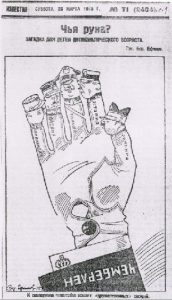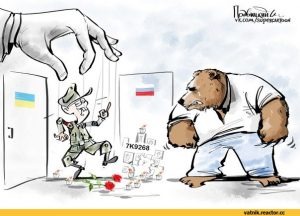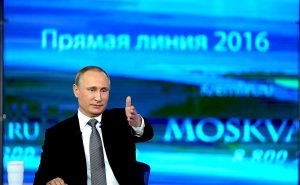By Emily Erdmann
On August 29, many students joined faculty to watch Miami’s own introduce the Havighurst Center for Russian and Post-Soviet Studies’ lecture series on “Truth and Power,” a complement to Miami’s Humanities Center lecture series on “Truth and Lies.” Walter E. Havighurst Professor of Russian History Stephen Norris and new Assistant Professor of Political Science, Hannah Chapman, juxtaposed past and present Russian propaganda.
Norris started the discussion by focusing on the past, in the era of Soviet propaganda. He argued that such propaganda served first and foremost to visually identify the enemies of communism, and, by so doing, generate a counter image of the ideal Soviet—the New Man and Woman the revolution wanted to create. Western capitalists were often depicted as lazy and overweight, while Soviets appeared physically strong and determined.
Norris drew on his current work in progress, a biography on Soviet political caricaturist Boris Efimov, to support his claims. Efimov is responsible for a staggering 9,000 plus propaganda cartoons, which, Norris noted, breaks down to one image generated per every three days of the USSR’s overall existence. The sheer number of caricatures leaves more than a little room for repetition—but this is no accident, said Norris. He explained that the nature of propaganda is reptition to the point of familiarity; the ideas behind these caricatures were intended to become second nature to viewers.
Soviet propaganda, Efimov’s work included, sought to cut through the rhetoric of the West and reveal what it deemed to be the true motivation behind Western involvement in communist affairs: desire for power, control, and money. Efimov depicts this with what Norris refers to as a number of cartoons focusing on the “Hands of the West,” always greedy and reaching out to take from the USSR.
Boris Efimov, “Whose Hand” (1925 Izvestiia Cartoon) with British Foreign Secretary Sir Austen Chamberlain controlling the leaders of Finland, Latvia, Poland, Estonia, and Romania.
Even though this segment of history is in the past, Norris concluded with the reminder that this propaganda stretches to the present with little variation. Vitalii Podvitskii, born in 1972, is the modern-day equivalent of Efimov. Using Uncle Sam as a metonymic representation of the United States and the capitalist West, Podvitskii sketches Western manipulation in Eastern foreign affairs for personal gain. Past and present lie on a continuum where the former is still bleeding into the latter.
Vitalii Podvitskii Cartoon.
Chapman’s follow-up on the present seemed to agree with Norris’s closing statement while taking the conversation in a different direction. As opposed to political cartoons, she addressed present-day propaganda as it appears on Russian television. Approximately ninety percent of Russians use the television to tune into political news on a weekly basis. Chapman suggested that this is a result of the Kremlin’s clever manipulation. She believes that the Kremlin understands it cannot close off society as the Soviet Union once did. Instead, it employs soft news programming as an entertaining means of incorporating more apathetic audiences into news media consumption. According to Chapman, the Kremlin’s strategy aims to get the population interested and involved; the issue has become not necessarily what is exposed, but how it is exposed and ultimately publicly discussed.
Chapman cited “The Direct Line with Vladimir Putin” as an example of such programming. Once a year, Putin goes on television to answer people’s questions as they call in. The show has a gameshow feeling as audiences wait to find out if they will be among the lucky ones who get to speak directly with the president. Simultaneously, Putin appears accessible, qualified, and revered like a celebrity. As Chapman put it, the show “deals with very serious issues and wraps it up in an atmosphere of showmanship.” As politicians are wont to do when topics get harried, Putin doles out a tasteful dose of “Whataboutism” in the face of heavy questions on the show. “Whataboutism” can be viewed as a form of red herring fallacy where the posed question is twisted back on the asker. Instead of directly answering the question at hand, Putin (and many other politicians) suggest that such issues (and perhaps even worse ones) are present elsewhere and in need of attention.
Source: By Kremlin.ru, CC BY 4.0, https://commons.wikimedia.org/w/index.php?curid=48187818
Chapman ultimately concluded with the notion that while propaganda may not be very good at changing opinions, it can strengthen preconceived notions and beliefs. RT is a popular television news source, which stems from Russia. Second only to BBC, RT is prevalent even so far as truck stops in rural Wyoming, Chapman exclaimed. Feeling overpowered by Western reporting, Russia is advancing on the international front, slowly but surely airing its perspective.
Although the first lecture was led by Miami faculty, future sessions on additional issues of Russian propaganda and political ideology will feature guest speakers such as Anna Veduta, the Global Outreach Director for English Meduza and former press secretary for Russian opposition leader Alexey Navalny. Her talk will take place in Harrison 111 at 4:30 p.m. on Thursday, September 20th.
An entire list of Havighurst lecture events can be found here: http://miamioh.edu/cas/academics/centers/havighurst/news-events/events/index.html. Russia’s prevalence in global affairs necessitates attention by more than just relevant faculty, majors, and minors—all are welcome to attend.
Emily Erdmann is a senior majoring in REEES and French.



